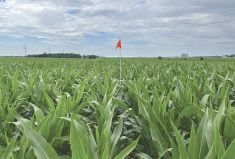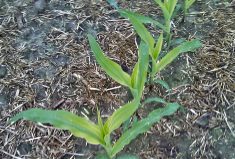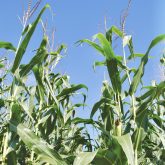Producers know that feeding high-quality silage can improve weight gain in beef cattle and increase milk production in dairy cows. So it makes sense to consider growing a corn hybrid bred specifically for silage rather than grain.
Francis Glenn, a corn breeder and president of Glenn Seed in Ontario, saw the opportunity for silage-specific corn in the 1980s when he was working with the leafy gene that had success producing large corn plants with large ears. However, other characteristics, including moist and fragile kernels and soft stalks, meant the leafy corn hybrids weren’t suitable for grain production.
Read Also

Youth focused on keeping Quebec’s dairy industry strong
In part two of our Making the Future series, Country Guide spoke with Béatrice Neveu from Rawdon, Que. (Read part…
While other breeders remained focused on grain hybrids, Glenn continued working with the leafy gene and focused his program on the development of silage-specific hybrids. Nineteen years ago, he discovered kernels on an ear of corn that were completely filled with the soft, white, floury starch that became the basis of the leafy floury corn hybrids in today’s marketplace.
To get the leafy floury seed, the breeders crossed a parent plant where the floury trait was uniform with a parent plant where the leafy trait was uniform. When planted, the seeds grew into leafy floury hybrid plants that must undergo sectional meiosis to set seed on the ear (meiosis is a process where a single cell divides twice to produce four cells containing half the original amount of genetic information).
“The meiosis gives the division of the floury, which is recessive, and the leafy, which is dominant, so 25 per cent of the kernels that are set on the ear are full flour,” Glenn says. “The other 75 per cent are like our other leafy hybrids in that they have a high proportion of the kernel that is floury.”
The big advantage of the greater floury endosperm is particle size in the final harvested product.
“It is well known now by nutritional scientists that the smaller and finer the particles of starch can be made, the more rapidly they become digestible in the silo and the more rapidly they can be digested in the cow.”
Glenn explains that while the kernels of the grain hybrid produce a meal that has a lot of hard, vitreous pieces and some floury starch in it, the kernels of the floury leafy hybrid produce a product with considerably more of the floury pieces and very small pieces of the vitreous pieces.
So, the new leafy floury hybrids have all the advantages of the leafy varieties — strong agronomics, high total plant yield, a long harvest win- dow, a short storage period, high fibre digestibility, high starch content, high starch digestibility, excellent feed quality and ration type adaptability. They also have the advantage of smaller particle size, which leads to even greater starch digestibility in the rumen, and ultimately more milk.
Focus on the cow
Tyler Russell, western Canadian man- ager for NorthStar Genetics, moderated a panel about leafy floury corn hybrids at the online Ag in Motion show in July. He says there is a big difference between corn hybrids bred for the grain market and those bred for silage.
“When you look at breeding for grain versus breeding for silage, there are a lot of opposing characteristics,” Russell says. “For silage, we’re looking for ‘how do we harvest that plant early in the season, maximize its total plant and total tonnage and get it to ferment as quickly as possible to be ultimately digestible in the cow.’ That really is our focus — the cow. That’s what they are designed for.”
Russell says that’s different than what’s in the marketplace today.
“Up to 90 per cent of the varieties in the marketplace today are bred for grain and a very different pathway to get as much cob, to get as many kernels and as much yield as they can,” he says. “They don’t necessarily care about the plant. They care about the structure to get it into the combine, to get it to dry down as fast as it can, to get it into an elevator, to get it into a railcar and to get it onto a barge to get it to its final destination. They care about the ship; we care about the cow.”
For silage, breeders want as much total plant with a moist kernel and which stays green as long as possible. They want kernels to be soft so they break up and can be easily chewed. They want large kernels to expose and get as many nutrients and as much breakage as possible. They want the stalk to be soft so it can be flexible. Ear height should be low because above the ear has more sugars and tends to have more high-digestible fibre.
Incorporating into rations
Ryan Hargreaves, sales manager with Country Farm Seeds in Ontario, has been incorporating floury leafy hybrids into rations for several years. He says the addition of the floury gene to the leafy varieties not only gives producers the tons per acre they want but also provides 10 to 12 per cent higher digestibility.
“What we generally notice is that the softer kernel at processing time going into the silo speeds up the ensile process, allowing for a fermented feed sooner out of the silo. The sooner you have a balanced product coming out, you will notice the milk production and fat production generally start going up within a few weeks or months after the fall harvest.”
Hargreaves has seen silage fermentation occur between 10 to 25 per cent faster in the bunk or the silo. This gives producers a balanced, fermented feed sooner so it is easier to balance the ration and easier for the cow to digest sooner.
He says the nice thing about switching to a silage-specific hybrid is there is very little a producer has to do differently except reduce seed- ing rates slightly. That’s because leafy and leafy floury varieties need some extra space to grow and expand and slightly lowering seeding rates can lead to more digestible stalks as well as larger ears.
“Some guys are still planting 34,000 plants per acre even for silage corn and we’d like to reduce that plants per acre to somewhere between 28,000 and 30,000 plants per acre because the nutrients are in the top part of the plant in silage,” Hargreaves says. “Also, with the flex ear, you allow for the ear to flex out and produce more kernels. You also get a bigger, wider leaf on the plant itself above the cob. That helps keep your tons per acre up and then you have your grain at a very good ratio.”
Tips to remember
Producers should keep in mind that not all areas of Western Canada have the heat units to successfully silage a longer-season leafy floury variety. For silage operations that don’t have their own silage harvester, choosing a silage-specific variety can help lengthen the window for harvesting.
If a rancher is using corn for grazing, producers may want to choose a variety with slightly longer heat units to correspond closely with proper maturity at frost dates, as well as slightly lowering seeding rates.
Finally, wherever growers are in the country, Russell recommends growing the variety that’s best suited for their region. “A variety will perform a little differently with heat units in Ontario than it will in the West,” he says.















